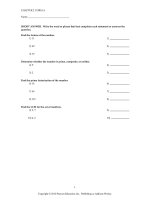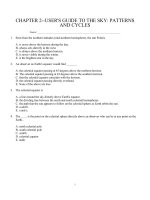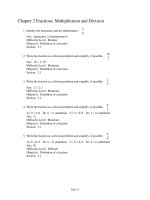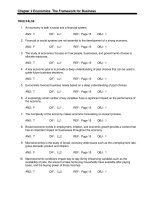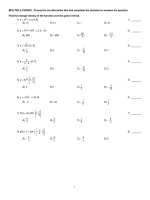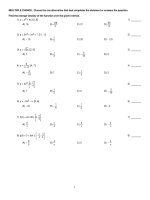Medical terminology complete 2nd edition wingerd test bank
Bạn đang xem bản rút gọn của tài liệu. Xem và tải ngay bản đầy đủ của tài liệu tại đây (196.64 KB, 29 trang )
CHAPTER 1: Introduction to Word Parts and Word Construction
MULTIPLE CHOICE. Choose the one alternative that best completes the statement or answers
the question.
1) The ________ spelling of a word indicates the way the word sounds, to facilitate correct
pronunciation.
A) erratic
B) eponymic
C) phonetic
D) acronymic
Answer: C
Explanation: To help you with pronunciation, the phonetic ("sounds like") form of the word is
provided in parentheses in the text whenever a new term is introduced. Eponyms are terms
derived from names of individuals. Acronyms are words derived from the first letters of words in
a compound term.
Page Ref: 2
Question Type: Spelling
Objective: 2
Taxonomy: Knowledge
2) In the term Wilms' tumor, Wilms' is an example of a:
A) word root
B) constructed term
C) combining form
D) nonconstructed term
Answer: D
Explanation: Nonconstructed terms, which are not formed from individual word parts, include
eponyms, which are terms derived from the names of people. In this case "Wilms'."
Page Ref: 5
Question Type: Constructed and Nonconstructed Terms
Objective: 3
Taxonomy: Application
3) Which medical term is an example of an acronym?
A) AIDS
B) Huntington's chorea
C) diabetes
D) appendicitis
Answer: A
Explanation: Acronyms are nonconstructed terms. They are words derived from the first letters
of words in a compound term. AIDS means Acquired Immune Deficiency Syndrome.
Page Ref: 5
Question Type: Constructed and Nonconstructed Terms
Objective: 3
Taxonomy: Application
4) Many medical terms are made of multiple word parts combined together. Such medical terms
are called:
A) abbreviations
B) acronyms
C) eponyms
D) constructed terms
Answer: D
Explanation: Word parts, including prefixes, suffixes, and word roots, and combining forms
create constructed terms. The key to learning constructed terms is to first learn the meaning of
the various word parts. Eponyms are terms derived from names of individuals. Acronyms are
words derived from the first letters of words in a compound term.
Page Ref: 5
Question Type: Constructed and Nonconstructed Terms
Objective: 3
Taxonomy: Knowledge
5) Some medical terms are derived from the names of important people. Such medical terms are
called:
A) acronyms
B) eponyms
C) abbreviations
D) constructed terms
Answer: B
Explanation: Nonconstructed terms, which are not formed from individual word parts, include
eponyms, which are terms derived from the names of people. Word parts, including prefixes,
suffixes, and word roots, or combining forms create constructed terms. Acronyms are words
derived from the first letters of words in a compound term.
Page Ref: 5
Question Type: Constructed and Nonconstructed Terms
Objective: 3
Taxonomy: Knowledge
6) The medical term LASIK, which stands for laser-assisted in situ keratomileusis, is an example
of a(n):
A) prefix
B) acronym
C) combining form
D) eponym
E) suffix
Answer: B
Explanation: Acronyms are nonconstructed terms. They are words derived from the first letters
of words in a compound term. LASIK stands for laser-assisted in situ keratomileusis.
Page Ref: 5
Question Type: Constructed and Nonconstructed Terms
Objective: 3
Taxonomy: Application
7) This type of word part is attached to the beginning of a word.
A) combining vowel
B) prefix
C) suffix
D) root
Answer: B
Explanation: A prefix is placed at the beginning of a term and is used to expand or enhance the
meaning of the word. You will know that a word part is a prefix in the text by the hyphen that
immediately follows it (for example, con-).
Page Ref: 6
Question Type: Word Parts
Objective: 4
Taxonomy: Knowledge
8) Which two languages have the most impact on the formation and meanings of medical terms?
A) Greek and French
B) Greek and Latin
C) English and German
D) Latin and Spanish
Answer: B
Explanation: The ancient Greeks are considered the fathers of modern medicine. The Romans
advanced medicine with their own experiments and observations. They added Latin terms to the
growing body of medical language.
Page Ref: 11
Question Type: Word Parts
Objective: 4
Taxonomy: Knowledge
9) This type of word part provides the primary meaning of the term.
A) root
B) combining vowel
C) prefix
D) suffix
Answer: A
Explanation: The word root provides the primary meaning for the term and is the part to which
other word parts are attached. The prefix is at the beginning to enhance the meaning. The suffix
is at the end to indicate the part of speech.
Page Ref: 6
Question Type: Word Parts
Objective: 4
Taxonomy: Knowledge
10) This type of word part is attached to the end of a word.
A) suffix
B) root
C) combining vowel
D) prefix
Answer: A
Explanation: The suffix is at the end of the word to indicate the part of speech (noun, verb,
adjective, adverb, etc.) or modify the word's meaning. You will know that a word part in the text
is a suffix by the hyphen that immediately precedes it (for example, -ion).
Page Ref: 6
Question Type: Word Parts
Objective: 4
Taxonomy: Knowledge
11) Which of the following statements is false?
A) All medical terms must have a prefix, root, and suffix.
B) Some medical terms are made of just a prefix and a suffix.
C) Some medical terms have more than one root.
D) Some medical terms are made of just a root and a suffix
Answer: A
Explanation: Some medical terms are not constructed using word parts (prefix, root, suffix).
Nonconstructed terms include eponyms and acronyms.
Page Ref: 5
Question Type: Constructed and Nonconstructed Terms
Objective: 4
Taxonomy: Synthesis
12) This word part is used to assist with pronunciation when combining a root with a suffix or
another root.
A) combining vowel
B) prefix
C) suffix
D) root
Answer: A
Explanation: A combining vowel is used when a word root is connecting to a suffix that begins
with a consonant, or when it is connecting to another word root.
Page Ref: 8
Question Type: Word Parts
Objective: 5
Taxonomy: Knowledge
13) In most cases, the combining vowel is the letter:
A) o
B) a
C) e
D) x
E) i
Answer: A
Explanation: In most cases, the combining vowel is the letter o, and in some cases it is the letter i
or e.
Page Ref: 8
Question Type: Word Parts
Objective: 5
Taxonomy: Knowledge
14) A combining form is made of:
A) a suffix and a combining vowel
B) a prefix and a root
C) a root and a combining vowel
D) a prefix and a suffix
Answer: C
Explanation: The word root plus its combining vowel creates the combining form used in term
construction. The method for writing a combining form involves the use of a slash between the
word root and the combining vowel, such as cardi/o.
Page Ref: 10
Question Type: Word Parts
Objective: 5
Taxonomy: Knowledge
15) Identify the combining vowel in the term hepatology.
A) hepat/o
B) hepat
C) o
D) -logy
Answer: C
Explanation: The letter o is utilized as the combining vowel to connect the root hepat to the
suffix -logy. The combining form (root plus vowel) is hepat/o.
Page Ref: 10
Question Type: Word Parts
Objective: 5
Taxonomy: Application
16) Cardi is an example of what word part?
A) word root
B) suffix
C) prefix
D) combining form
Answer: A
Explanation: The word root provides the primary meaning of the term. In this example, the heart.
Page Ref: 9
Question Type: Word Parts
Objective: 4
Taxonomy: Application
17) You are building a medical term using the root hepat. Which of the following suffixes would
require you to use a combining vowel?
A) -ectomy
B) -ic
C) -logy
D) -itis
Answer: C
Explanation: The letter o is utilized as the combining vowel to connect the root hepat to the
suffix -logy starting with the consonant l. All the other suffixes start with a vowel and do not
require the addition of another vowel for pronunciation.
Page Ref: 13
Question Type: Forming Words from Word Parts
Objective: 5
Taxonomy: Application
18) You are building a medical term using the root neur. Which of the following suffixes would
require you to use a combining vowel?
A) -itis
B) -emia
C) -al
D) -tic
Answer: D
Explanation: The letter o is utilized as the combining vowel to connect the root neur to the suffix
-tic starting with the consonant t to allow pronunciation. All of the other suffixes begin with a
vowel.
Page Ref: 13
Question Type: Forming Words from Word Parts
Objective: 5
Taxonomy: Application
19) What is the definition of the medical term neonatal?
A) new birth
B) condition of a new nose
C) pertaining to a newborn
D) pertaining to a narrow nose
Answer: C
Explanation: The prefix neo- means new. The root nat means birth. The suffix -al means
pertaining to.
Page Ref: 15
Question Type: Forming Words from Word Parts
Objective: 6
Taxonomy: Synthesis
20) What prefix means before?
A) preB) antiC) epiD) postAnswer: A
Explanation: Anti- means against, opposite of. Epi- means upon, over, above, on top. Postmeans to follow after.
Page Ref: 15
Question Type: Forming Words from Word Parts
Objective: 4
Taxonomy: Knowledge
21) Study of the skin is the definition of what medical term?
A) dermatology
B) neurology
C) hepatopathy
D) biology
Answer: A
Explanation: The combining form dermat/o means skin. The suffix -logy means study of. The
combining form is utilized because the suffix begins with a consonant.
Page Ref: 10
Question Type: Forming Words from Word Parts
Objective: 6
Taxonomy: Synthesis
22) What is the medical term that means pertaining to the brain?
A) hepatic
B) psychic
C) cerebral
D) pancreatic
Answer: C
Explanation: The root cerebr means cerebrum, which is the largest part of the brain. The suffix al means pertaining to. No combining vowel is needed, as the root ends with a consonant and the
suffix starts with a vowel.
Page Ref: 15
Question Type: Forming Words from Word Parts
Objective: 6
Taxonomy: Synthesis
23) Which medical term has two word roots?
A) electrocardiogram
B) hysterectomy
C) microhepatic
D) cardiopathy
Answer: A
Explanation: The constructed medical term uses combining vowels to unite two word roots,
electr and cardi with the suffix -gram.
Page Ref: 15
Question Type: Forming Words from Word Parts
Objective: 5
Taxonomy: Application
24) What is the definition of the medical term psychology?
A) study of the mind
B) a brain specialty
C) inflammation of the brain
D) disease of the mind
Answer: A
Explanation: The combining form psych/o means mind. The suffix -logy means study of. Note
the o is part of the combining form as the suffix being added, -logy, starts with a consonant.
Page Ref: 15
Question Type: Forming Words from Word Parts
Objective: 6
Taxonomy: Application
25) What is the definition of the suffix -scope?
A) an instrument used for viewing
B) study of instruments
C) use of an instrument for viewing
D) pertaining to instruments
Answer: A
Explanation: Note the subtle difference: -scopy means use of an instrument for viewing, -scope is
the suffix denoting the actual instrument. A physician performing an arthroscopy (viewing inside
a joint) will utilize the tool the arthroscope to perform the procedure.
Page Ref: 15
Question Type: Forming Words from Word Parts
Objective: 4
Taxonomy: Knowledge
26) Which medical term is spelled correctly?
A) osteoitis
B) hepatology
C) cardiapathy
D) artarioscope
Answer: B
Explanation: The combining vowel o is utilized to connect the suffix -logy starting with a
consonant. The other terms add combining vowels, which are not necessary and make the terms
difficult to pronounce.
Page Ref: 8
Question Type: Word Parts
Objective: 5
Taxonomy: Application
27) What word parts make up the medical term proctoscopy?
A) prefix, word root, combining vowel, suffix
B) word root, combining vowel, suffix
C) prefix, combining vowel, word root
D) prefix, word root, suffix
Answer: B
Explanation: Proct is the root requiring the combining vowel o to connect to the suffix -scopy,
which starts with a consonant.
Page Ref: 15
Question Type: Forming Words from Word Parts
Objective: 4
Taxonomy: Application
28) Which combining form means nose?
A) nat/o
B) rhin/o
C) narc/o
D) vas/o
Answer: B
Explanation: Nat/o means birth. Narc/o means numbness. Vas/o means vessel.
Page Ref: 15
Question Type: Word Parts
Objective: 4
Taxonomy: Knowledge
29) What is a suffix that means surgical repair?
A) -scopy
B) -logy
C) -lepsy
D) -plasty
Answer: D
Explanation: It might be easy to confuse -plasty, a surgical repair, with -scopy, which is the
process of viewing, which is also an invasive procedure.
Page Ref: 15
Question Type: Word Parts
Objective: 4
Taxonomy: Knowledge
30) What is the meaning of the prefix anti-?
A) under
B) away from
C) excess
D) against
Answer: D
Explanation: Don't confuse anti- against with ab-, which means away from.
Page Ref: 15
Question Type: Word Parts
Objective: 4
Taxonomy: Knowledge
31) Identify the suffix in the term cardiology.
A) cardi/o
B) cardi
C) o
D) -logy
Answer: D
Explanation: The suffix is located at the end of the word to indicate the part of speech and
modify the meaning.
Page Ref: 10
Question Type: Word Parts
Objective: 4
Taxonomy: Application
32) Identify the combining form in the term dermatology.
A) -logy
B) dermat
C) o
D) dermat/o
Answer: D
Explanation: The combining form is the root dermat plus the combining vowel o.
Page Ref: 10
Question Type: Word Parts
Objective: 5
Taxonomy: Application
33) Identify the combining form in the term laryngoscopy.
A) o
B) laryng/o
C) -scopy
D) laryng
Answer: B
Explanation: The combining form is the root laryng with the combining vowel o.
Page Ref: 15
Question Type: Word Parts
Objective: 5
Taxonomy: Application
34) Identify the suffix in the term hepatitis.
A) o
B) -itis
C) hepat/o
D) hepat
Answer: B
Explanation: The suffix is at the end of the term to indicate the part of speech and modify the
meaning. The vowel i is part of the suffix -itis.
Page Ref: 15
Question Type: Word Parts
Objective: 4
Taxonomy: Application
35) Identify the prefix in the term antibiotic.
A) bi
B) o
C) antiD) bi/o
E) -tic
Answer: C
Explanation: The prefix is at the start of the term to expand or enhance the meaning.
Page Ref: 15
Question Type: Word Parts
Objective: 4
Taxonomy: Application
36) Identify the combining form in the term antibiotic.
A) antiB) bi
C) bi/o
D) -tic
E) o
Answer: C
Explanation: The root bi along with the vowel o is the combining form. It would be difficult to
pronounce the term antibitic; so the combining vowel is added.
Page Ref: 15
Question Type: Word Parts
Objective: 5
Taxonomy: Application
37) Identify the suffix in the term antibiotic.
A) o
B) bi/o
C) antiD) bi
E) -tic
Answer: E
Explanation: The suffix is at the end of the term to indicate the part of speech or clarify the
meaning.
Page Ref: 15
Question Type: Word Parts
Objective: 4
Taxonomy: Application
38) Identify the suffix in the term mastectomy.
A) mast/o
B) -ectomy
C) o
D) mast
Answer: B
Explanation: The suffix is at the end of the term to identify the part of speech or clarify the
meaning. Do not confuse -ectomy, surgical excision/removal, with -tomy, incision/cut.
Page Ref: 15
Question Type: Word Parts
Objective: 4
Taxonomy: Application
39) Identify the combining form in the term mammogram.
A) mamm
B) mamm/o
C) -gram
D) o
Answer: B
Explanation: The combining form is utilized as the vowel o is required to connect the root mamm
to the suffix -gram, which starts with a consonant.
Page Ref: 15
Question Type: Word Parts
Objective: 5
Taxonomy: Application
40) Identify the combining form in the term psychology.
A) psych/o
B) -logy
C) psych
D) o
Answer: A
Explanation: The combining form is the root psych with the vowel added o. This is required to
connect the suffix -logy, which begins with a consonant.
Page Ref: 15
Question Type: Word Parts
Objective: 5
Taxonomy: Application
41) Choose the combining form that means heart.
A) cardi/o
B) hem/o
C) psych/o
D) dermat/o
Answer: A
Explanation: The combining form cardi/o refers to the heart.
Page Ref: 15
Question Type: Word Parts
Objective: 5
Taxonomy: Knowledge
42) Choose the combining form that means white.
A) electr/o
B) rhin/o
C) path/o
D) leuk/o
Answer: D
Explanation: Specific word parts identifying colors are utilized to create terms. Leuk/o means
white as in leukoderma, a condition where the skin becomes lighter or whiter.
Page Ref: 15
Question Type: Word Parts
Objective: 5
Taxonomy: Knowledge
43) Choose the suffix that means surgical excision (removal).
A) -ectomy
B) -emia
C) -logy
D) -scopy
Answer: A
Explanation: Do not confuse -ectomy, surgical excision/removal, with -tomy, incision/cut.
Page Ref: 15
Question Type: Word Parts
Objective: 4
Taxonomy: Knowledge
44) Choose the suffix that means study of.
A) -plasty
B) -logy
C) -ectomy
D) -scopy
Answer: B
Explanation: Note that this suffix meaning the study of starts with the consonant l. When
constructing terms utilizing -logy, you will often need to add the combining vowel o, as in
neurology.
Page Ref: 15
Question Type: Word Parts
Objective: 4
Taxonomy: Knowledge
45) Choose the suffix that means surgical repair.
A) -plasty
B) -gram
C) -logy
D) -scopy
Answer: A
Explanation: It might be easy to confuse -plasty, a surgical repair, with -scopy, which is the
process of viewing, which is also an invasive procedure.
Page Ref: 15
Question Type: Word Parts
Objective: 4
Taxonomy: Knowledge
46) Choose the prefix that means slow.
A) antiB) microC) bradyD) hyperAnswer: C
Explanation: It might be easy to confuse the prefix brady-, slow, with micro-, small. Slow heart
rate is called bradycardia, but an abnormally small heart is termed microcardia.
Page Ref: 15
Question Type: Word Parts
Objective: 4
Taxonomy: Knowledge
47) Choose the prefix that means small.
A) antiB) microC) epiD) neoAnswer: B
Explanation: Anti- means against. Epi- means above. Neo- means new.
Page Ref: 11
Question Type: Word Parts
Objective: 4
Taxonomy: Knowledge
48) Choose the prefix that means against.
A) microB) hyperC) bradyD) antiAnswer: D
Explanation: Micro- means small. Hyper- means excessive, abnormally high, above. Bradymeans slow.
Page Ref: 15
Question Type: Word Parts
Objective: 4
Taxonomy: Knowledge
49) Choose the suffix that means pertaining to.
A) -ic
B) -tic
C) -al
D) all of the above
Answer: D
Explanation: Sometimes more than one word part has the same meaning.
Page Ref: 15
Question Type: Word Parts
Objective: 4
Taxonomy: Knowledge
50) This type of word part comes before a word root.
A) combining vowel
B) suffix
C) prefix
D) none of the above
Answer: C
Explanation: The prefix is at the beginning of the word to expand or enhance the meaning of the
word.
Page Ref: 6
Question Type: Word Parts
Objective: 4
Taxonomy: Knowledge
51) Which of the following cannot come after a word root?
A) prefix
B) suffix
C) another root
D) combining vowel
Answer: A
Explanation: The prefix is at the beginning of the word to expand or enhance the meaning of the
word.
Page Ref: 6
Question Type: Word Parts
Objective: 4
Taxonomy: Knowledge
SHORT ANSWER. Write the word or phrase that best completes each statement or answers the
question.
52) A(n) ________ is a medical term derived from the name of an important person.
Answer: eponym
Page Ref: 5
Question Type: Constructed and Nonconstructed Terms
Objective: 3
Taxonomy: Knowledge
53) A(n) ________ is a word part attached to the beginning of a word.
Answer: prefix
Page Ref: 6
Question Type: Word Parts
Objective: 4
Taxonomy: Knowledge
54) A(n) ________ is a word part attached to the end of a word.
Answer: suffix
Page Ref: 6
Question Type: Word Parts
Objective: 4
Taxonomy: Knowledge
55) A word ________ is a word part that provides the primary meaning of a word.
Answer: root
Page Ref: 6
Question Type: Word Parts
Objective: 4
Taxonomy: Knowledge
56) A(n) ________ is added to a root to assist with pronunciation when combining with other
word parts. (2 words)
Answer: combining vowel
Page Ref: 8
Question Type: Word Parts
Objective: 5
Taxonomy: Knowledge
57) A combining form is made of a(n) ________ and a combining vowel.
Answer: root
Page Ref: 9
Question Type: Word Parts
Objective: 5
Taxonomy: Knowledge
58) The most common combining vowel is the letter ________.
Answer: o
Page Ref: 10
Question Type: Word Parts
Objective: 5
Taxonomy: Knowledge
59) In the constructed term mast/o/plasty, the combining vowel is ________.
Answer: o
Page Ref: 10
Question Type: Word Parts
Objective: 5
Taxonomy: Application
60) In the constructed term brady/cardi/a, the prefix is ________.
Answer: brady-; brady
Page Ref: 11
Question Type: Word Parts
Objective: 4
Taxonomy: Application
61) What does the prefix micro- mean?
Answer: small
Page Ref: 15
Question Type: Word Parts
Objective: 4
Taxonomy: Knowledge
62) In the medical term laryngectomy, what is the word root?
Answer: laryng
Page Ref: 15
Question Type: Word Parts
Objective: 6
Taxonomy: Application
63) The medical term hepatic means pertaining to disease of the ________.
Answer: liver
Page Ref: 15
Question Type: Word Parts
Objective: 6
Taxonomy: Application
64) The medical term hepatitis means inflammation of the ________.
Answer: liver
Page Ref: 15
Question Type: Word Parts
Objective: 6
Taxonomy: Application
65) The medical term that means treatment of the mind is ________.
Answer: psychiatry
Page Ref: 15
Question Type: Word Parts
Objective: 6
Taxonomy: Knowledge
66) The definition of pathology is the study of ________.
Answer: disease
Page Ref: 15
Question Type: Word Parts
Objective: 6
Taxonomy: Knowledge
67) The meaning of gastritis is inflammation of the ________.
Answer: stomach
Page Ref: 15
Question Type: Word Parts
Objective: 6
Taxonomy: Application
68) What is the definition of encephalogram? It is a recording of the ________.
Answer: brain
Page Ref: 15
Question Type: Word Parts
Objective: 6
Taxonomy: Application
69) In the constructed term leuk/emia, the suffix is ________.
Answer: -emia; emia
Page Ref: 15
Question Type: Word Parts
Objective: 4
Taxonomy: Application
70) In the constructed term rhin/o/plasty, the combining form is ________.
Answer: rhin/o; rhino
Page Ref: 15
Question Type: Word Parts
Objective: 5
Taxonomy: Application
71) In the constructed term electr/o/cardi/o/gram, the first combining form is ________.
Answer: electr/o; electro
Page Ref: 15
Question Type: Word Parts
Objective: 5
Taxonomy: Application
72) In the constructed term electr/o/cardi/o/gram, the suffix is ________.
Answer: -gram; gram
Page Ref: 15
Question Type: Word Parts
Objective: 4
Taxonomy: Application
73) In the constructed term endo/cardi/al, the prefix is ________.
Answer: endo-; endo
Page Ref: 15
Question Type: Word Parts
Objective: 4
Taxonomy: Application
74) In the constructed term endo/cardi/al, the suffix is ________.
Answer: -al; al
Page Ref: 15
Question Type: Word Parts
Objective: 4
Taxonomy: Application
75) In the constructed term mast/o/plasty, the suffix is ________.
Answer: -plasty; plasty
Page Ref: 15
Question Type: Word Parts
Objective: 4
Taxonomy: Application
76) In the constructed term laryng/itis, the suffix is ________.
Answer: -itis; itis
Page Ref: 15
Question Type: Word Parts
Objective: 4
Taxonomy: Application
77) In the constructed term hyster/ectomy, the suffix is ________.
Answer: -ectomy; ectomy
Page Ref: 15
Question Type: Word Parts
Objective: 4
Taxonomy: Application
78) In the constructed term micr/o/scope, the suffix is ________.
Answer: -scope; scope
Page Ref: 15
Question Type: Word Parts
Objective: 4
Taxonomy: Application
79) In the constructed term hem/o/philia, the combining form is ________.
Answer: hem/o; hemo
Page Ref: 15
Question Type: Word Parts
Objective: 5
Taxonomy: Application
80) In the constructed term hem/o/philia, the combining vowel is ________.
Answer: o
Page Ref: 13
Question Type: Word Parts
Objective: 5
Taxonomy: Application
81) In the constructed term psych/o/logy, the word root is ________.
Answer: psych
Page Ref: 13
Question Type: Word Parts
Objective: 4
Taxonomy: Application
82) In the constructed term psych/o/logy, the suffix is ________.
Answer: -logy; logy
Page Ref: 15
Question Type: Word Parts
Objective: 4
Taxonomy: Application
83) In the constructed term ment/al, the suffix is ________.
Answer: -al; al
Page Ref: 15
Question Type: Word Parts
Objective: 4
Taxonomy: Application
84) In the constructed term tonsill/ectomy, the word root is ________.
Answer: tonsill
Page Ref: 15
Question Type: Word Parts
Objective: 4
Taxonomy: Application
85) In the constructed term tonsill/ectomy, the suffix is ________.
Answer: -ectomy; ectomy
Page Ref: 15
Question Type: Word Parts
Objective: 4
Taxonomy: Application
86) In the constructed term neur/o/logy, the suffix is ________.
Answer: -logy; logy
Page Ref: 15
Question Type: Word Parts
Objective: 4
Taxonomy: Application
87) In the constructed term path/o/logy, the combining form is ________.
Answer: path/o; patho
Page Ref: 15
Question Type: Word Parts
Objective: 5
Taxonomy: Application
88) In the constructed term psych/iatry, the suffix is ________.
Answer: -iatry; iatry
Page Ref: 15
Question Type: Word Parts
Objective: 4
Taxonomy: Application
89) Two languages that had an important impact on medical terminology are ________ and
Latin.
Answer: Greek
Page Ref: 11
Question Type: Word Parts
Objective: 4
Taxonomy: Knowledge
Define the following combining forms, roots, prefixes, and suffixes.
90) The combining form cardi/o means pertaining to the ________.
Answer: heart
Page Ref: 15
Question Type: Word Parts
Objective: 4
Taxonomy: Knowledge
91) The combining form dermat/o means pertaining to the ________.
Answer: skin
Page Ref: 15
Question Type: Word Parts
Objective: 4
Taxonomy: Knowledge
92) The combining form hepat/o means pertaining to the ________.
Answer: liver
Page Ref: 15
Question Type: Word Parts
Objective: 4
Taxonomy: Knowledge
93) The suffix meaning surgical excision or removal is ________.
Answer: -ectomy; ectomy
Page Ref: 15
Question Type: Word Parts
Objective: 4
Taxonomy: Knowledge
94) The prefix meaning against or opposite of is ________.
Answer: anti-; anti
Page Ref: 15
Question Type: Word Parts
Objective: 4
Taxonomy: Knowledge
95) The combining form psych/o means pertaining to the ________.
Answer: mind
Page Ref: 15
Question Type: Word Parts
Objective: 4
Taxonomy: Knowledge
96) The combining form rhin/o means pertaining to the ________.
Answer: nose
Page Ref: 15
Question Type: Word Parts
Objective: 4
Taxonomy: Knowledge
97) The suffix -plasty means surgical ________.
Answer: repair
Page Ref: 15
Question Type: Word Parts
Objective: 4
Taxonomy: Knowledge
TRUE/FALSE. Write 'T' if the statement is true and 'F' if the statement is false.
98) In the medical term cardiologist, the first o sound is pronounced as "all."
Answer: True
Page Ref: 4
Question Type: Pronunciation
Objective: 2
Taxonomy: Application
99) An acronym is a term that is an abbreviation for a word or words.
Answer: False
Explanation: Acronyms are words derived from the first letters of words in a compound term,
such as LASIK for laser-assisted in situ keratomileusis
Page Ref: 5
Question Type: Constructed and Nonconstructed Terms
Objective: 3
Taxonomy: Knowledge
100) A prefix is the word part attached to the end of a medical term.
Answer: False
Explanation: The prefix is attached to the beginning of a term to expand or enhance its meaning.
Page Ref: 6
Question Type: Word Parts
Objective: 4
Taxonomy: Knowledge
101) When a medical term is constructed from word parts, its definition usually starts with the
definition of the suffix.
Answer: True
Page Ref: 7
Question Type: Word Parts
Objective: 4
Taxonomy: Application
102) A medical term must have four parts: a prefix, a word root, a combining vowel, and a
suffix.
Answer: False
Explanation: Some terms are nonconstructed such as eponyms or acronyms, and others can
utilize two word roots or sometimes none.
Page Ref: 8
Question Type: Word Parts
Objective: 3

